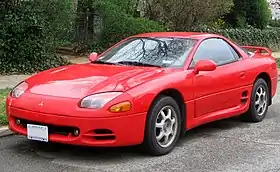Mitsubishi GTO
The Mitsubishi GTO is a front-engine, all-wheel/front-wheel drive grand touring/sports car manufactured and marketed by Mitsubishi from 1990-2000 over a single generation. Manufactured in a three-door hatchback coupé body style in Nagoya, Japan, the 2+2 four-seaters were marketed in the Japanese domestic market (JDM) as the GTO; globally as Mitsubishi 3000GT — and in North America as the Mitsubishi 3000GT (1991–1999 ) as well as the Dodge Stealth (1991–1996), a badge engineered, mechanically identical captive import. As a collaborative effort between Chrysler and Mitsubishi Motors, Chrysler was responsible for the Stealth's exterior styling.[1][2]
| Mitsubishi GTO (Z15A/Z16A) | |
|---|---|
 Mitsubishi 3000GT | |
| Overview | |
| Manufacturer | Mitsubishi Motors |
| Also called |
|
| Production |
|
| Assembly | Japan: Okazaki, Aichi (Nagoya Plant) |
| Designer | Masaru Suzuki (1987) |
| Body and chassis | |
| Class |
|
| Body style |
|
| Layout | Transverse front-engine, front-/four-wheel drive |
| Platform |
|
| Related | |
| Powertrain | |
| Engine | |
| Transmission | |
| Dimensions | |
| Wheelbase | 2,470 mm (97.2 in) |
| Length | 4,600 mm (181.1 in) |
| Width | 1,840 mm (72.4 in) |
| Height | 1,285 mm (50.6 in) |
| Curb weight |
|
| Chronology | |
| Predecessor | Mitsubishi Starion |
The marketing variants were all based on Mitsubishi's Sigma/Diamante and retained their transverse mounted 3-liter, 24-valve V6 engines and front-wheel-drive layout.[3] The GTO's engines were naturally aspirated or with twin-turbochargers and were also available with active aerodynamics (automatically adjusting front and rear spoilers), four-wheel-steering, full-time all-wheel-drive and adaptive suspension.[2]
Mitsubishi marketed a retractable hardtop variant, which were engineered and converted from coupé models in California by ASC,[4] and marketed as the GTO Spyder or VR4 Spyder for model years 1993-1995.[5] These were the first fully automated retractable hardtop marketed since the 1959 Ford Skyliner.[6]
The JDM model took its name from the Galant GTO, a two-door hardtop coupé marketed by the company in the early 1970s, which in turn took its name from the Ferrari 250 GTO, short for Gran Turismo Omologata which signified that it met motorsport homologation regulation.
Overview
.jpg.webp)
_rear.jpg.webp)
Following the successful showing of the Mitsubishi HSR and Mitsubishi HSX concept cars at the 1989 Tokyo Motor Show,[7] Mitsubishi unveiled the new GTO as a 2+2 seating grand touring car in order to compete with the Mazda Cosmo, Nissan 300ZX, Subaru SVX, and the Toyota Supra. They resurrected the GTO name, and the car went on to serve as Mitsubishi's flagship for the remainder of the decade. Despite the cachet of the badge at home, it was marketed as the Mitsubishi 3000GT and as the Dodge Stealth outside Japan; the company was concerned that connoisseurs would object to the evocative nameplate from the highly regarded Ferrari 250 GTO and Pontiac GTO being used on a Japanese vehicle.
Each was built on the same production line at Mitsubishi's plant in Nagoya, Japan.[8] Its Japanese introduction coincided with the softening Japanese economy, subsequently known as the "bubble economy".
JDM GTOs were marketed at Mitsubishi's Car Plaza retail chain, with JDM buyers paying additional annual road tax as well as elevated taxes for being classified as a large car by Japan's exterior dimension regulations.
A Dodge Stealth was scheduled as a 1991 Indianapolis 500 pace car, until the United Auto Workers (UAW) rejected it because of its Japanese rather than US-manufacture. A prototype of the Dodge Viper was substituted in place of it.[9] Still used as a backup pace car, eventual race winner Rick Mears received a Dodge Stealth for winning the race and dealers sold pace car replica editions, as the Viper did not begin production until later that year.[10]
1990–1993 Z16A
Early models were internally designated Z16A and incorporated full-time four-wheel drive, four-wheel steering, active aerodynamics with automatically adjusting front and rear spoilers, sport/tour exhaust modes and electronically controlled suspension (ECS).[11] The GTO, 3000GT and Stealth featured pop-up headlights and articulated blister caps on the hood to accommodate the ECS controllers at the top of the strut turrets. The Dodge Stealth featured a signature cross-hair front bumper fascia and crescent-shaped rear spoiler — and did not include active aerodynamics. In 1993 the engine went to a 4 bolt main and a forged crankshaft, some of the early models in 1993 still received the cast crank present in the first years.[12] In the U.S., both the 1991 to 1993 Dodge Stealth R/T Turbo and Mitsubishi 3000GT VR-4 received the transversely mounted 24V V6 paired with a long ratio 5-speed manual. The base model Stealth was the only model to feature crank windows, without the sunroof it weighted at 3075 pounds or 1395kg.[13] All the other models received electronic windows (automatic on the driver side). Automatic climate control was standard on all turbo models. The Stealth turbo weights 3800 pounds compared to the 3814 pounds of the VR-4. The non turbo 3000gt (with sunroof) weights 3373 pounds and 3200 without the sunroof.[14] Electronically adjustable leather seats were standard on all US VR-4 while the GTO in japan were offered with slightly lighter cloth seats.

Magazines from the era praised its brutal acceleration and AWD grip. By 1993 all electronic gadgets were still standard on the VR-4 model, with magazines quoting 0-60 mph (97 km/h) acceleration times ranging from sub 5 seconds[15] to 6.3 seconds and quarter mile times of 13.6-13.9 seconds at 95–98 mph (153–158 km/h)[16][17] Dodge claims a 0-60 of 4.89 seconds for the 1991 RT turbo models. [18] Only 3000GT models outside Japan could be configured with front-wheel drive rather than all-wheel drive. In Japan, the base GTO SR included all-wheel drive; no front-wheel drive version was offered. The GTO SR had similar power output figures as the US spec 3000GT SL and was offered with a different five-speed manual or four-speed automatic transmissions. The transmissions in japanese models NA models had different gear ratios and a different part number. Japanese buyers did not receive the SOHC V6 which was standard on the base model Dodge Stealth and US spec 3000GT starting in 1997. Japanese buyers had the choice of either a naturally aspirated DOHC V6 and twin-turbocharged DOHC V6.
In Europe, instead of the TD04-09B turbochargers used on Japanese and US Twin Turbo models, the EU-spec model received the higher capacity TD04-13G turbochargers. While power output is no higher than contemporary market models, these have lower discharge temperatures to better handle the prolonged high speeds possible on the German Autobahn, along with an upgraded transmission.[19] The engine was rated at 286 PS (210 kW; 282 hp); the modifications took time and European models only went on sale in the Autumn of 1992.[20] In 1994, Mitsubishi released a limited edition of what was now the previous generation 3000GT, branded as "Beckenbauer Edition." Honoring Franz Beckenbauer. All were painted Lamborghini yellow and were equipped with a Remus sports exhaust, OZ Futura rims, a numbered plate signed by Beckenbauer, and a C-net mobile phone system. Only 30 were made, sold through 1995.[21][22]
| Model name | Engine | Peak power | Peak torque |
|---|---|---|---|
| Dodge Stealth (United States, Canada) | SOHC 12v V6 | 164 hp (122 kW; 166 PS) at 5,500 rpm | 251 N⋅m (185 lb⋅ft) at 4,000 rpm |
| Mitsubishi GTO SR (Japan) | DOHC 24v V6 | 225 PS (165 kW; 222 hp) at 6,000 rpm | 275 N⋅m (203 lb⋅ft) at 4,500 rpm |
| Mitsubishi 3000GT, 3000GT SL (United States); Dodge Stealth ES, Stealth R/T (United States, Canada) | DOHC 24v V6 | 222 hp (166 kW; 225 PS) at 6,000 rpm | 272 N⋅m (201 lb⋅ft) at 4,500 rpm |
| Mitsubishi GTO Twin Turbo (Japan) | DOHC 24v V6 twin turbo | 280 PS (206 kW; 276 hp) at 6,000 rpm | 417 N⋅m (308 lb⋅ft) at 2,500 rpm |
| Mitsubishi 3000GT VR-4 (United States); Dodge Stealth R/T Twin-Turbo (United States, Canada) | DOHC 24v V6 twin turbo | 300 hp (224 kW; 304 PS) at 6,000 rpm | 417 N⋅m (308 lb⋅ft) at 2,500 rpm |
| Mitsubishi 3000GT (Europe) | DOHC 24v V6 twin turbo | 210 kW (286 PS; 282 hp) at 6,000 rpm | 407 N⋅m (300 lb⋅ft) at 3,000 rpm |
1994–1997 Z15A (2WS) and Z16A (4WS)
Facelift models were internally designated Z15A (2WS) and Z16A (4WS) and featured a revised front bumper to accommodate projector beam headlights and small, round projector fog lights. They were unveiled in August 1993 in Japan and gradually made their way to other markets as the earlier cars sold out. Some markets didn't get these models until 1996, such as the UK.[23] The caps on the hood were replaced with integrated sheet metal blisters, and revised side air vents and rear bumpers were added. The interior was redesigned with dual air bags, a new audio system, and revised air conditioning refrigerant. The engines in the twin-turbo models received an increase to 320 hp (239 kW) and an increase in torque from 307 to 315 lb⋅ft (416 to 427 N⋅m). Japanese models received an increase in torque, but the power rating remained unchanged at 280 PS (206 kW; 276 hp).
The VR-4 model now included a six-speed Getrag manual transmission with revised gear ratios, especially in lower gears like 3rd which went until approximately 107 mph (172 km/h) (vs the first generation 3000GT VR-4's third gear which went until 120 mph (193 km/h). Larger wheel/tire combinations were provided beginning in 1995. The base and SL model received 16" wheels in silver or chrome with 225/55 tires, while the VR4 now had 18" chrome wheels with 245/40 tires (the Spyder had the standard 17" with higher profile tires from 1994 to handle the additional 400 lb (180 kg) of weight). With subsequent price increases, features were discontinued: the tunable exhaust was phased out after 1994 model year, the ECS after 1995 model year, and the active aerodynamics disappeared after 1996. This was also when Chrysler ceased sales of the Dodge Stealth captive import, and for the remainder of its life only Mitsubishi-badged versions were available.
Chrysler and Mitsubishi worked with ASC to engineer and convert 3000GTs into retractable hardtops, marketed as the Spyder VR4 for 1995 and 1996 model years.
In 1995, Mitsubishi's 3000GT Spyder was available in four color combinations: red with grey leather interior, black with ivory leather interior, white pearl with grey, and martinique yellow with ivory leather interior. In 1996 the 3000GT Spyder was available in red with tan interior, black pearl with tan leather, white pearl with tan leather interior, and green pearl with tan leather. SL Spyders were only available with an automatic transmission while the VR4 Spyder was only available with a 6-speed manual.
GTO MR
The GTO MR model appeared in the Japanese market in August 1994. The ‘Mitsubishi Racing’ or MR moniker, has been used in most performance Mitsubishis such as the Lancer Evolution, and usually meant a lighter model. The GTO MR was essentially a lightweight GTO Twin Turbo that deleted 4WS, ABS, ECS and Active Aero, but was mechanically identical to the normal GTO Twin Turbo. Chassis numbers for the MR start with Z15A. This allowed the MR edition to reach a weight of 3637 pounds. The awd system featured in the MR received the same 45% front 55% rear split ratio as the other turbo models.[24]
Best Motoring, a Japanese television program about Japanese cars, debuted the 1994 GTO MR in an hour long program where it beat the lighter R32 Skyline GT-R over a mile in acceleration.[25]
Reception
The redesign of the second generation 3000GT was well received, especially the loss of pop up headlights and smoother hood. As the years went on, the Tuneable Exhaust System was phased out in 1995 and the Active Aero was phased out in 1996. The new 6-speed was geared well and paired with the extra horsepower and torque allowed the car to out-accelerate its rivals from a standing start. A notable change was the brake redesign, facelift models received 2 pot rear calipers and larger front brakes that showed no sign of fading under heavy use unlike the early models. Braking distances remained similar. These changes made all models lighter, the vr-4 was now 3737 pounds and the sl 3263 pounds.[26] Road tests at the time showed the second generation 3000GT VR-4 to be capable of 60 mph (97 km/h) in 4.8 - 5.4 seconds[27] and the quarter mile in 13.5 seconds at 101 to 105 miles per hour (163 to 169 km/h), making it faster in a straight line than the Nissan 300ZX Twin Turbo and Mazda RX-7 Twin Turbo.[28][2][29] Though heavy, it could be taken around a track quickly, with noted under steer and a feeling of nose heaviness.
| Model name | Engine | Peak power | Peak torque |
|---|---|---|---|
| Dodge Stealth (United States, Canada) | SOHC 12v V6 | 119 kW (162 PS; 160 hp) at 5,500 rpm | 250 N⋅m (184 lb⋅ft) at 4,000 rpm |
| Mitsubishi 3000GT, 3000GT SL, 3000GT SL Spyder (United States); Mitsubishi GTO SR (Japan); Stealth R/T (United States, Canada) | DOHC 24v V6 | 166 kW (226 PS; 223 hp) at 6,000 rpm | 277 N⋅m (204 lb⋅ft) at 4,500 rpm |
| Mitsubishi GTO twin turbo, GTO MR (Japan) | DOHC 24v V6 twin turbo | 206 kW (280 PS; 276 hp) at 6,000 rpm | 427 N⋅m (315 lb⋅ft) at 2,500 rpm |
| Mitsubishi 3000GT VR-4, 3000GT VR-4 Spyder (United States); Dodge Stealth R/T twin-turbo (United States, Canada) | DOHC 24v V6 twin turbo | 238.4 kW (324 PS; 320 hp) at 6,000 rpm | 427 N⋅m (315 lb⋅ft) at 2,500 rpm |
1997–2000 Z15AM
.jpg.webp)
The SOHC engine, previously only available in the base model Stealth, was added to the Mitsubishi range after the Dodge version was discontinued. Slower sales in the American sports car market led to a planned facelift for 1997 being abandoned in favor of minor cosmetic adjustments, including a new front bumper and rainbow shaped arched type wing. The 3000gt's featuring the single cam engine had a weight of 3131 pounds, noted that they were not offered with the sunroof and leather seats. In 1999, the car received another exterior makeover, including a new aggressive front bumper, headlamps, turn signals, sail panels, and a true inverted airfoil spoiler coined the "Combat Wing" for the 1999 VR-4 to distinguish it from previous models. The 1999 non turbo models kept the arched style spoiler. 1999 was the final year the 3000GT was available in the U.S. market. With sales slowing to a trickle and new side impact regulations looming, production for the Japanese domestic market finally ceased in 2000.[30] A last two cars were sold the following year.[31] In a test by Popular Mechanics the VR-4 ran a 13.44 seconds quarter mile (~402 m) at 101.7 mph (163.7 km/h).[32]
| Model name | Engine | Peak power | Peak torque |
|---|---|---|---|
| Mitsubishi 3000GT (United States) | SOHC 12v V6 | 119 kW (162 PS; 160 hp) at 5,500 rpm | 250 N⋅m (184 lb⋅ft) at 4,000 rpm |
| Mitsubishi 3000GT SL (United States); Mitsubishi GTO SR (Japan) | DOHC 24v V6 | 163 kW (222 PS; 219 hp) at 6,000 rpm | 277 N⋅m (204 lb⋅ft) at 4,500 rpm |
| Mitsubishi GTO twin turbo, Mitsubishi GTO MR (Japan) | DOHC 24v V6 twin turbo | 206 kW (280 PS; 276 hp) at 6,000 rpm | 427 N⋅m (315 lb⋅ft) at 2,500 rpm |
| Mitsubishi 3000GT VR-4 (United States) | DOHC 24v V6 twin turbo | 238.4 kW (324 PS; 320 hp) at 6,000 rpm | 427 N⋅m (315 lb⋅ft) at 2,500 rpm |
All years Z11A
The Z11A chassis code was used for the 3000GT ES and SL, and the base Dodge Stealth. The Mitsubishis lacked the "twin turbo" writing on the faux windows. The Dodges had different bumpers than the turbo cars. Otherwise the non-turbo cars looked cosmetically like the turbo cars. These cars were front wheel drive and lacked four-wheel steering and active aero. They came with a 5 speed manual (F5M33) or with automatic transmissions. Both the DOHC and SOHC 6G72 V6 was offered in this platform, with the DOHC being the more powerful.
Gallery
 The Active Aero spoiler on a 1992 3000GT VR-4
The Active Aero spoiler on a 1992 3000GT VR-4 1991 Dodge Stealth Indy 500 official car
1991 Dodge Stealth Indy 500 official car A 1991 Dodge Stealth RT
A 1991 Dodge Stealth RT A 1995 base model 3000GT
A 1995 base model 3000GT
References
Notes
- "Dodge Stealth". Allpar.
- Perkins, Chris (January 12, 2016). "The 1994 Mitsubishi 3000GT VR4 Was Too Far Ahead of its Time". Road & Track.
- "Near-luxury Mitsubishi Diamante has an Aussie accent". Boca Raton News. AutoWeek. 1997-09-28. Retrieved 2019-06-21.
- "3000GT Spyder - ASC Production, The Making of a Retractable Hardtop". 3000GT Spyder Registry.
- "History, Revival". Retractable Hardtop Online. Retrieved 3 February 2014.
- "Disappearing Top On Auto Worked By Push Button". Popular Mechanics. 63 (2): 253. February 1935. Retrieved 14 August 2013.
- Motor Trend, January 1990
- "3000GT/Stealth Production Numbers", Michael Reid & Jeff Lucius, stealth316.com, 2000–2004
- Levin, Doron P (1991-02-26). "A Pace Car Made (Quickly) in U.S." The New York Times.
- Strohl, Daniel (2019-01-03). "Were it not for the UAW, the Dodge Stealth R/T would have been the true Indy 500 pace car in 1991". Hemmings Motor News.
- GTO at Mitsubishi Web Museum Archived 2006-10-22 at the Wayback Machine
- http://www.stealth316.com/2-2bolto4bolt.htm. Missing or empty
|title=(help) - https://www.edmunds.com/dodge/stealth/1991/features-specs/. Missing or empty
|title=(help) - https://www.edmunds.com/mitsubishi/3000gt/1991/features-specs/. Missing or empty
|title=(help) - Strohl, Daniel (2019-01-03). "Were it not for the UAW, the Dodge Stealth R/T would have been the true Indy 500 pace car in 1991". Hemmings Daily. Retrieved 2019-08-27.
- St. Antoine, Arthur (1991-08-01). "Nissan 300ZX Turbo vs. Dodge Stealth R/T Turbo". Car and Driver. Retrieved 2019-08-25.
- "1991 Dodge". www.lov2xlr8.no. Retrieved 2019-08-27.
- https://www.youtube.com/watch?v=BOi6cyFqh1w. Missing or empty
|title=(help) - "BPT-MHI-3000GT 13G Turbochargers (Pair)". Blouch Performance Turbo. Archived from the original on 2016-08-04.
- Aichele, Tobias, ed. (1992). Auto Katalog 1993 (in German). Stuttgart: Vereinigte Motor-Verlage GmbH & Co. KG. p. 136.
- GmbH, Pixelgenau Consulting. "Galerie - Autohaus Bernd Klügl in 64646 Heppenheim". www.mitsubishi-kluegl.de (in German). Retrieved 2018-06-03.
- "3000GT Franz Beckenbauer Edition". 3si.org. 15 July 2011. Retrieved 15 March 2020.
- "Mitsubishi 3000GT (1992 - 2000)". Honest John. Retrieved 2019-09-17.
- https://www.automobile-catalog.com/car/1994/1967075/mitsubishi_gto_twin-turbo_mr.html. Missing or empty
|title=(help) - https://www.youtube.com/watch?v=KHPh3KT6BNM. Missing or empty
|title=(help) - https://www.edmunds.com/mitsubishi/3000gt/1997/features-specs/. Missing or empty
|title=(help) - "Mitsubishi 3000GT VR-4, Porsche 911 Turbo, and Toyota Supra Turbo - Performance Imports". 1 May 1997. Retrieved 21 June 2019.
- "Virtual Velocity - Cover Story - MotorTrend". MotorTrend. 1 July 1995. Retrieved 16 June 2019.
- "1994-1999 Mitsubishi 3000GT VR4 / GTO / 3000 GT VR-4 - Modern Racer - Auto Archive". www.modernracer.com. Retrieved 21 June 2019.
- Ishida, Shinichi (2000-07-13). "スポーツカーは不必要、三菱『FTO』と『GTO』が揃って廃止" [Sports cars unnecessary, Mitsubishi FTO and GTO discontinued]. Response.jp (in Japanese). IID, Inc. Archived from the original on 2016-06-24.
- Fact & Figures 2005 Archived 2007-03-05 at the Wayback Machine, Mitsubishi Motors website
- Popular Mechanics. Hearst Magazines. July 1999. p. 86. Retrieved 18 June 2019.
Bibliography
- Jackson, Terry (1992). Japanese Super Cars. London: Apple Press. pp. 6–11, 32–43. ISBN 1850763658.
External links
![]() Media related to Mitsubishi GTO at Wikimedia Commons
Media related to Mitsubishi GTO at Wikimedia Commons
- GTO press release, Mitsubishi-motors.com, August 25, 1998 (Japanese)
- Mitsubishi GTO at Curlie